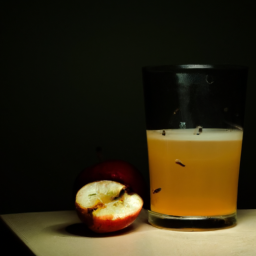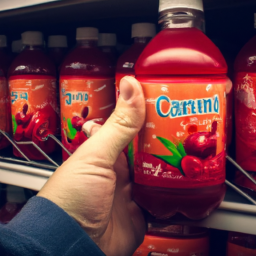After experiencing constipation myself, I empathize with the frustration of trying to find relief. Many people recommend prune juice as a solution, but I’ve always wondered how long its effects last, a question that I’m sure has crossed the minds of many others as well.
Prune juice is a natural laxative that has been used for centuries to relieve constipation. It’s high in fiber and sorbitol, a sugar alcohol that helps soften stool and promote bowel movements. But while prune juice can be effective in relieving constipation, the duration of its effects can vary depending on a number of factors.
In this article, we’ll explore the benefits of prune juice, how it relieves constipation, and how long you can expect its effects to last.
Key Takeaways
- Prune juice takes 2-6 hours to have a laxative effect.
- The laxative effect of prune juice can last up to 24 hours.
- Drinking too much prune juice can cause diarrhea, dehydration, and electrolyte imbalances.
- To avoid negative side effects, start with a small amount of prune juice and gradually increase dosage.
The Benefits of Prune Juice
Looking for a delicious and natural way to improve your digestion? Look no further than prune juice – it’s packed with fiber and antioxidants that can help keep your gut healthy and happy! Not only does prune juice taste great, but it also has a variety of health benefits.
There are many prune juice recipes available, so you’re sure to find one that suits your tastes. Prune juice is particularly helpful for digestive health. The fiber in prune juice can help regulate bowel movements and prevent constipation. Additionally, prune juice contains sorbitol, a natural laxative that can further aid in digestion.
Incorporating prune juice into your diet can be a simple and effective way to keep your digestive system healthy. Now, let’s look at how prune juice relieves constipation.
How Prune Juice Relieves Constipation
After drinking prune juice, you’ll feel like a smooth operator as your bowels are gently encouraged to release their contents. This is because prune juice contains sorbitol, a natural sugar alcohol that acts as a laxative.
Sorbitol draws water into the colon, which softens and lubricates the stool, making it easier to pass. In addition to its laxative properties, prune juice also helps with hydration and digestion.
The high water content of prune juice can help prevent dehydration, which can lead to constipation. Furthermore, the fiber in prune juice helps regulate digestion by promoting the growth of beneficial gut bacteria and aiding in the absorption of nutrients.
Overall, the combination of sorbitol, hydration, and digestion benefits make prune juice an effective natural remedy for constipation. When it comes to the effects of prune juice, there are several factors that can affect how long it takes for the laxative properties to kick in. Let’s take a closer look at these factors in the next section.
Factors Affecting the Effects of Prune Juice
To fully experience the benefits of prune juice as a natural laxative, you should pay attention to factors influencing its effectiveness. First, it’s important to maintain proper hydration levels in order to ensure that your digestive system is functioning properly. Drinking enough water throughout the day can help soften stool and make it easier to pass.
Secondly, the frequency of consumption can also affect the effectiveness of prune juice. Drinking it regularly can help regulate bowel movements, while consuming it infrequently may not have the desired effect. Lastly, everyone’s digestive system is unique, so finding the optimal dosage of prune juice may require some experimentation.
In order to determine the optimal dosage of prune juice for your individual needs, it’s important to start with a small amount and gradually increase as needed. It’s generally recommended to start with 4-8 ounces of prune juice per day and adjust accordingly. It’s also important to note that the effects of prune juice can take several hours to kick in, so it’s best to consume it in the morning or early afternoon.
With these factors in mind, you can maximize the benefits of prune juice as a natural laxative. Moving forward, let’s explore how long prune juice can take to work.
How Long Can Prune Juice Take to Work?
It’s important to note that prune juice can take up to six hours to have a laxative effect, according to a study published in the Journal of the American College of Nutrition. The effectiveness of prune juice largely depends on how much and how frequently it is consumed. Drinking a small amount of prune juice may not have an immediate effect, while consuming too much may cause cramping and diarrhea. Therefore, it’s recommended to start with a small amount and gradually increase the intake over time to determine the optimal amount for an individual.
To better understand the time frame of prune juice effectiveness, the following table outlines the approximate time range for the laxative effects of prune juice based on different amounts consumed:
| Amount of Prune Juice Consumed | Time Range for Laxative Effect |
|---|---|
| 4 ounces | 4-6 hours |
| 8 ounces | 2-4 hours |
| 12 ounces | 1-2 hours |
While the effectiveness of prune juice can vary based on individual factors, such as metabolism and digestive health, it’s generally safe to assume that the laxative effects can last for several hours. However, it’s important to note that consuming too much prune juice can lead to unpleasant side effects and potential health risks.
How Long Do the Effects of Prune Juice Last?
You may be wondering how much time you have before you need to be near a bathroom after drinking prune juice, so let’s dive into the duration of its laxative effects. Here are some things to keep in mind about prune juice dosage and effectiveness:
- Prune juice typically takes between 2-6 hours to have a laxative effect on the body.
- The effects of prune juice can last for up to 24 hours, depending on the individual’s digestive system.
- Drinking too much prune juice at once can lead to diarrhea, dehydration, and electrolyte imbalances.
- It’s important to start with a small amount of prune juice and gradually increase the dosage to avoid negative side effects.
Overall, prune juice can be an effective natural remedy for constipation, but it’s important to be mindful of the dosage and potential side effects.
Speaking of which, let’s now explore the possible side effects of prune juice.
Side Effects of Prune Juice
If you drink too much prune juice, be aware that it can lead to diarrhea, dehydration, and electrolyte imbalances, which can be harmful to your body. In fact, studies have shown that consuming more than 2 cups of prune juice in one sitting can cause these negative side effects.
It’s important to understand that these side effects do not last very long and typically go away after a few hours. However, it’s recommended to avoid consuming excessive amounts of prune juice to prevent these uncomfortable symptoms.
If you experience any of these side effects, it’s important to manage them appropriately. To prevent dehydration, make sure to drink plenty of water and electrolyte-rich fluids such as sports drinks. Additionally, it may be helpful to consider alternatives to prune juice such as psyllium husk, flaxseed, or other natural laxatives.
These alternatives are often less harsh on the digestive system and can help prevent the side effects associated with prune juice. By being aware of the potential risks and managing side effects appropriately, prune juice can still be a helpful home remedy for constipation.
Now, let’s explore other home remedies for constipation.
Other Home Remedies for Constipation
I’ve found that there are several other home remedies for constipation besides prune juice. These remedies include making dietary changes, staying hydrated, and exercising regularly.
By making these lifestyle changes, I’ve found relief from constipation without relying solely on medication.
Dietary Changes
Eating more fiber-rich foods can help regulate bowel movements and alleviate constipation, which can have a longer term effect on digestive health. Here are three ways to boost your fiber intake:
-
Add more fruits and vegetables to your diet. These foods are naturally high in fiber and can help keep your digestive system moving smoothly.
-
Choose whole grain breads and cereals instead of their refined counterparts. Whole grains contain more fiber and can help keep you feeling full longer.
-
Snack on nuts and seeds. These foods are also high in fiber and can be a healthy addition to your diet.
Increasing water consumption is also important for maintaining regular bowel movements. Drinking plenty of fluids can help soften stools and make them easier to pass.
In the next section, we’ll discuss the role of hydration in promoting healthy digestion.
Hydration
Staying hydrated is crucial for maintaining healthy digestion, and drinking enough water throughout the day can help prevent constipation and promote regular bowel movements.
In addition to water, other hydrating fluids such as herbal tea, coconut water, and fruit juice can help keep the body hydrated. However, it’s important to limit sugary drinks and caffeine as they can actually dehydrate the body.
Hydration tips include carrying a water bottle with you throughout the day, setting reminders to drink water, and incorporating hydrating foods into your diet such as watermelon, cucumber, and celery.
It’s recommended that adults drink at least 8 glasses of water per day, but this can vary depending on individual needs and activity level. The importance of water intake cannot be overstated, as it not only supports digestion and bowel movements, but also aids in overall bodily functions such as regulating body temperature and delivering nutrients to cells.
Drinking enough water is just one aspect of maintaining a healthy digestive system. Another important factor is exercise, which can help stimulate bowel movements and improve digestion.
Exercise
Get moving and incorporate regular exercise into your routine to help improve your digestive health and promote regular bowel movements. Endurance training is especially effective in keeping your digestive system functioning properly. It involves activities that elevate your heart rate for an extended period and strengthens your abdominal muscles, making it easier to pass stool. It also helps to reduce stress, which can contribute to constipation.
Muscle soreness is a common side effect of exercising, and it can make it difficult to move around comfortably. However, it’s a temporary discomfort that can be mitigated by stretching before and after exercise, staying hydrated, and taking a warm bath or shower after exercising. If muscle soreness persists for more than a few days, it may be a sign of injury, and you should seek medical attention.
In the next section, we will discuss when to seek medical attention for constipation.
When to Seek Medical Attention for Constipation
When it comes to treating constipation at home, prune juice is often a go-to remedy. However, it’s important to use it in moderation to avoid any potential negative effects.
If constipation persists despite using home remedies, it’s important to consult with a healthcare provider to rule out any underlying medical conditions.
Prune Juice as an Effective Home Remedy
Prune juice, when consumed in appropriate amounts, can be an effective home remedy for constipation. This is because prunes contain high amounts of fiber and sorbitol, which help to soften the stool and promote bowel movements.
Drinking prune juice can also help to lubricate the intestines and prevent dehydration, which are both important factors in relieving constipation. There are many ways to incorporate prune juice into your diet. You can drink it straight, mix it with other juices, or even use it in prune juice recipes such as muffins or smoothies.
Additionally, prune juice has alternative uses such as promoting bone health and reducing the risk of certain diseases. However, it’s important to consume prune juice in moderation as excessive intake can lead to diarrhea and abdominal discomfort.
Importance of Moderation
It’s crucial to consume prune juice in moderation to avoid experiencing uncomfortable digestive symptoms.
While prune juice is an effective home remedy for constipation and digestive issues, excessive use can lead to diarrhea, cramps, and bloating. Drinking too much prune juice can also cause an imbalance in electrolytes, which can lead to dehydration and other health concerns.
To avoid these issues, it’s important to limit your intake of prune juice. A good rule of thumb is to start with a small amount, such as 4-6 ounces per day, and gradually increase your intake if needed. It’s also important to drink plenty of water and eat a balanced diet to maintain healthy bowel movements.
Avoiding excessive use of prune juice can ensure that you receive its benefits without any negative side effects.
To ensure that prune juice is safe for your individual health needs, consultation with a healthcare provider is recommended. They can provide guidance on proper usage and help you determine if prune juice is the best option for your specific digestive issues.
Consultation with Healthcare Provider
If you’re unsure about whether or not prune juice is right for you, consulting with a healthcare provider can be like having a compass to guide you on your journey to better digestive health. Your healthcare provider can help you determine the right dosage of prune juice to consume, as well as provide you with information on alternative remedies and natural options that can help alleviate constipation.
During a consultation, your healthcare provider may recommend other natural options such as increasing your water intake, increasing your fiber intake, and engaging in regular exercise. They may also suggest probiotics, magnesium supplements, or other natural supplements that can help with digestive issues.
By working with your healthcare provider, you can develop a personalized plan to improve your digestive health and find relief from constipation.
Frequently Asked Questions
What are some other health benefits of prune juice besides relieving constipation?
Prune juice is a good source of dietary fiber and sorbitol which can aid in gut health. It also contains antioxidants like beta-carotene and vitamin E which can protect cells from damage.
Can consuming too much prune juice be harmful?
Consuming too much prune juice can have side effects such as cramping, diarrhea, and gas. It is important to follow recommended dosage and listen to your body. Prune juice side effects vary depending on the individual.
Is prune juice safe to drink during pregnancy?
As someone concerned about pregnancy safety, I can confirm that prune juice is generally safe to drink during pregnancy. It also has nutritional benefits like high fiber content which aids digestion.
Are there any precautions to take when drinking prune juice with certain medications?
When drinking prune juice with certain medications, it is important to be aware of potential drug interactions. Dosage recommendations may need to be adjusted to avoid adverse effects. Always consult with a healthcare provider before consuming prune juice with any medication.
Can prune juice be used as a long-term solution for chronic constipation?
Oh, yes, of course! I’d love to trade in my meals for prune juice every day for the rest of my life. Kidding aside, while prune juice efficacy is known, it’s not a long-term solution. Alternatives for constipation management should also be considered.
Conclusion
So, how long do the effects of prune juice last? While it varies from person to person, the effects of prune juice typically last for about 6-8 hours. This is due to the high fiber content in prune juice, which helps to promote bowel movements and relieve constipation.
However, if the constipation is severe or chronic, it may require more than just prune juice to alleviate the symptoms. It’s important to note that while prune juice is a natural and effective home remedy for constipation, it may not work for everyone. Additionally, consuming too much prune juice can lead to diarrhea and other gastrointestinal discomforts.
Therefore, it’s crucial to speak with a healthcare professional before adding prune juice to your diet as a regular remedy for constipation. In conclusion, while prune juice can be a helpful tool in relieving constipation, it’s essential to use it in moderation and consult with a healthcare professional if the constipation persists.
As with any medical condition, it’s imperative to listen to your body and seek medical attention if necessary. So, next time you’re looking for a natural remedy for constipation, ask yourself – is prune juice the right choice for me?
Ilana has been a vegan for over 10 years. She originally made the switch for health reasons, but soon found herself becoming more and more passionate about the ethical and environmental implications of a vegan lifestyle. Ilana is the author of The Graceful Kitchen, a blog all about veganism. She loves to cook up delicious and nutritious vegan meals, and share her recipes with others who are interested in leading a cruelty-free life. Ilana is also a strong advocate for using whole foods as the foundation of a healthy diet, and believes that going vegan is one of the best ways to achieve this.










